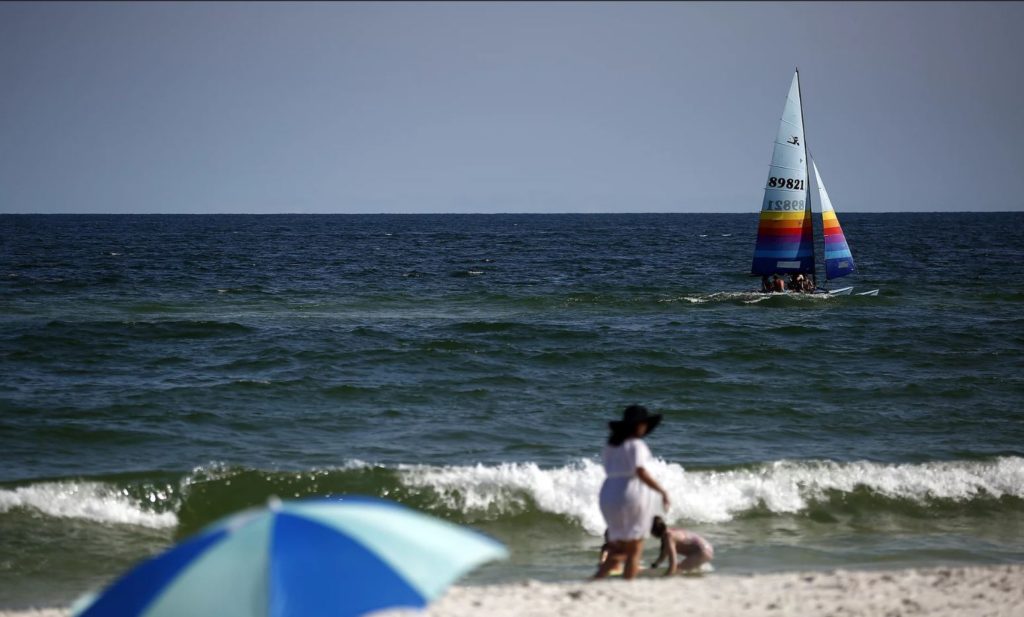At the peak of the summer vacation season, a flesh-eating bacteria has infected the shores of the Gulf Coast.
From Texas to Florida, the water-borne bug – a strain called a Vibrio vulnificus – has spooked locals and tourists in the way shark attacks do: infections are rare, but when they strike, the victim is likely to lose a limb or die.
There is no central authority tracking cases – states are not required to report cases to the Centers for Disease Control (CDC), in Atlanta – so no one holds current, comprehensive statistics for deaths and illnesses.
People, including public officials, have started to cobble together their own ideas.
“I’ve got my theory,” said Kim Farve, director of public works in Bay St Louis, Mississippi. “They say this Vibrio has been in the water forever. But I grew up on the water, and I don’t remember it ever being a problem until after the [2010] BP oil spill.”
Down the coast in Biloxi, Jocko Angle described an identical theory. His left leg is swollen to twice the size of his right, following a battle with Vibrio three years ago, and he now runs a Facebook page called Vibrio Along the Gulf Coast, where fearful residents go for information and victims commiserate.
“I think the oil in the water, combined with the chemicals they used, created the perfect environment for Vibrio to thrive,” he said.
There is usually an uptick in cases, Angle said, after heavy rains stir up murky wetlands water, especially when the water is warm.
“We’ve had a lot of rain,” he said. “Now we’ve got crowds coming in for the Fourth of July holiday. Mark my words: someone is going to get it this weekend.”
Vibrio can infect humans in two ways: through raw seafood, like oysters, or through contact with a cut or wound, even if the cut is invisible. Once in the body, the bacteria infiltrates the layer of flesh between muscle and skin, where it releases a toxin that destroys the tissue.
States can voluntarily report infections to the CDC, where the latest report dates from 2014. That year, 97 people were hospitalized with Vibrio vulnificus, and 21 died. The Food and Drug Administration reports a higher death rate – 50%.
Among the people who survive, most come away from the encounter like 69-year-old Dick Empson did, this past week.
Empson and his wife had traveled from Baton Rouge to the Mississippi coast for a vacation, and he fished in the shallows along the shore. He was physically fit, with no cuts or sores. At about 2am last Monday, he woke up with an undefinable ill feeling. He took two Tylenol.
Later, the couple got up and decided to return home. “It came on so fast,” said Empson’s sister-in-law, Loni Daggett. “By the time they had packed their things, he said, ‘I can’t make the drive home. I need to go to the hospital.’”
By 3am on Tuesday, doctors had amputated his leg.
On Wednesday, Empson woke from his coma, and indicated with his hands that he wanted to know how much of his leg was gone. His wife took his hand and helped him feel it: mid-thigh.
The psychology of such a loss is devastating. When they removed Empson’s breathing tube, Daggett said, his first words were: “It’s my fault. I should have known not to go in the water.”
Last week, along the beach in Hancock County, Mississippi, there were no notices about Vibrio visible on the beach or in parking areas. Beach crowds were noticeably thin, and fewer people entered the water.
Jon and Heather Helvie, of Larned, Kansas, had travelled to Mississippi to visit their son at college, and spent an afternoon on the beach. Before their trip, they had heard of so-called flesh-eating infections in Texas and Florida, but they thought the water in Ocean Springs, Mississippi, was safe.
“We won’t be getting in anymore,” Heather said, when told about Dick Empson’s case.
Nearby, two women and a small child played in the water. Adrienne Gerstenecker, from Boston, and Rosie Colomb, from New Orleans, splashed with Colomb’s little girl. Both were taken aback to learn about Vibrio. It may be rare, Colomb said, but the consequences are too severe to risk.
She pulled her daughter from the water. Gerstenecker squinted, looking in each direction on the beach.
“You would think they would at least put up a sign,” she said.
guardian.co.uk © Guardian News & Media Limited 2010
Published via the Guardian News Feed plugin for WordPress.
